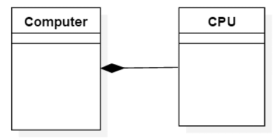组合
-
说明:组合和聚合,不是C++的语法要求,是应用中的常用手段。
-
需求:
构建一个计算机类,一台计算机,由CPU芯片,硬盘,内存等组成。
CPU芯片也使用类来表示。
?
CPU.h
#pragma once
#include <string>
using namespace std;
class Cpu{
public:
Cpu(string brand = "Inter", string model = "i5");
~Cpu();
private:
string brand; //品牌
string model; //型号
};
?
CPU.cpp
#include "Cpu.h"
#include <iostream>
Cpu::Cpu(string brand, string model){
this->brand = brand;
this->model = model;
cout << "Cpu 开始" << endl;
}
Cpu::~Cpu(){
cout << "Cpu 结束" << endl;
}
?
Computer.h
#pragma once
#include <string>
#include <iostream>
#include <Windows.h>
#include "Cpu.h"
using namespace std;
class Computer{
public:
Computer(string cpuBrand, string cpuModel, int hardDisk, int memory);
~Computer();
private:
Cpu cpu; //Cpu类和Computer类之间, 就是"组合"
//Cpu *cpu; //指针方式
int hardDisk; //硬盘
int memory; //内存
};
?
Computer.cpp
#include "Computer.h"
//cpu的参数使用列表初始化
Computer::Computer(string cpuBrand, string cpuModel,
int hardDisk, int memory) : cpu(cpuBrand, cpuModel)
{
//使用指针方式初始化
//this->cpu = new Cpu(cpuBrand, cpuModel);
this->hardDisk = hardDisk;
this->memory = memory;
cout << "计算机 开始" << endl;
}
Computer::~Computer(){
//指针释放内存
//delete cpu;
cout << "计算机 结束" << endl;
}
?
main.cpp
#include "Computer.h"
using namespace std;
void test() {
Computer computer("英特尔", "i9 11900k", 512, 32);
}
int main(void) {
//当test函数结束以后
//计算机和Cpu就会全部销毁
test();
system("pause");
return 0;
}
?

?
小结:
被拥有的对象(cpu芯片)的生命周期与其拥有者(计算机)的生命周期是一致的。
计算机被创建时,cpu芯片也随之创建。
计算机被销毁时,cpu芯片也随之销毁。
拥有者需要对被拥有者负责,是一种比较强的关系,是整体与部分的关系。
具体组合方式:
1)被组合的对象直接使用成员对象。(常用)
2)使用指针表示被组合的对象,在构造函数中,创建被组合的对象;在析构函数中,释放被组合的对象。
?
?
UML中的组合表示:

注意包含者使用实心菱形
【补充】UML画图工具:starUML